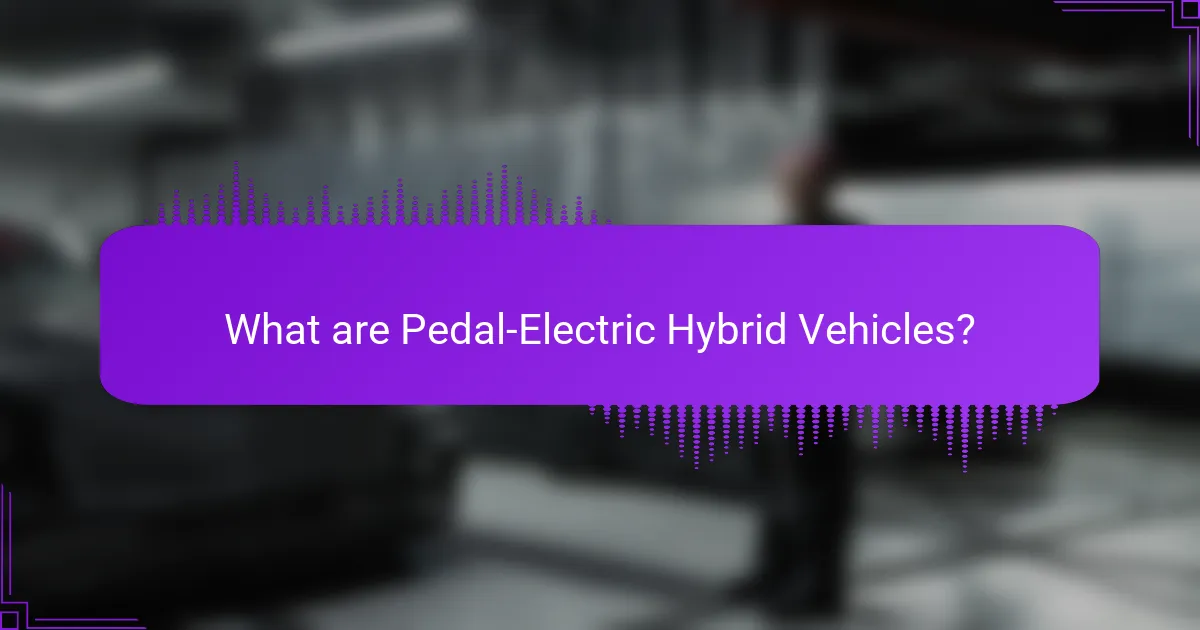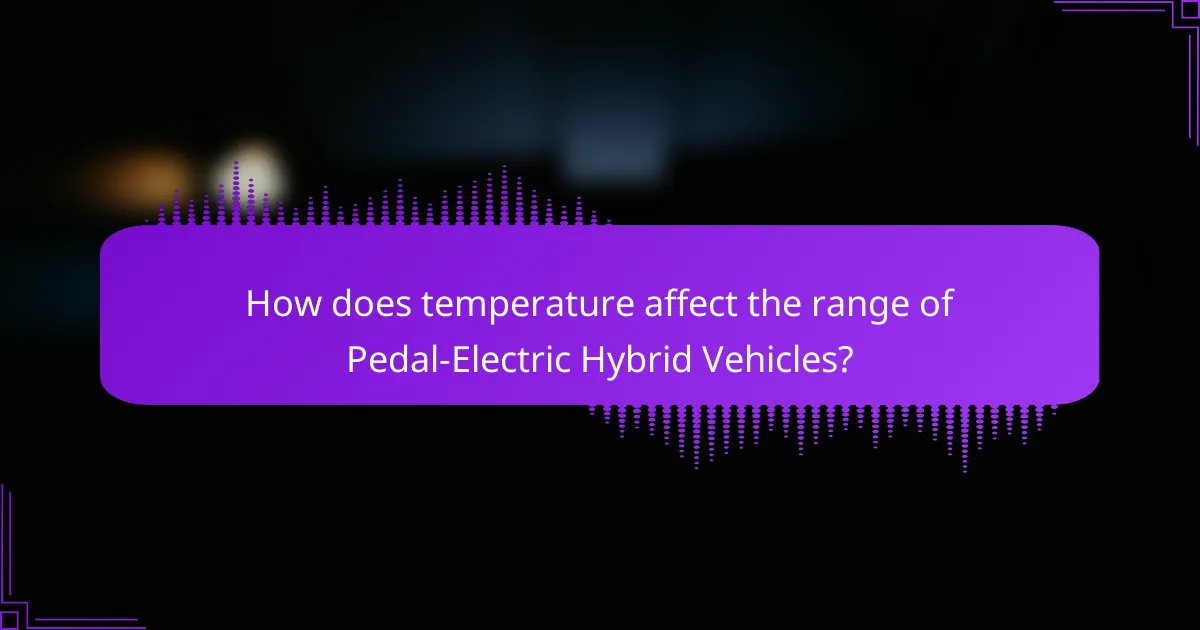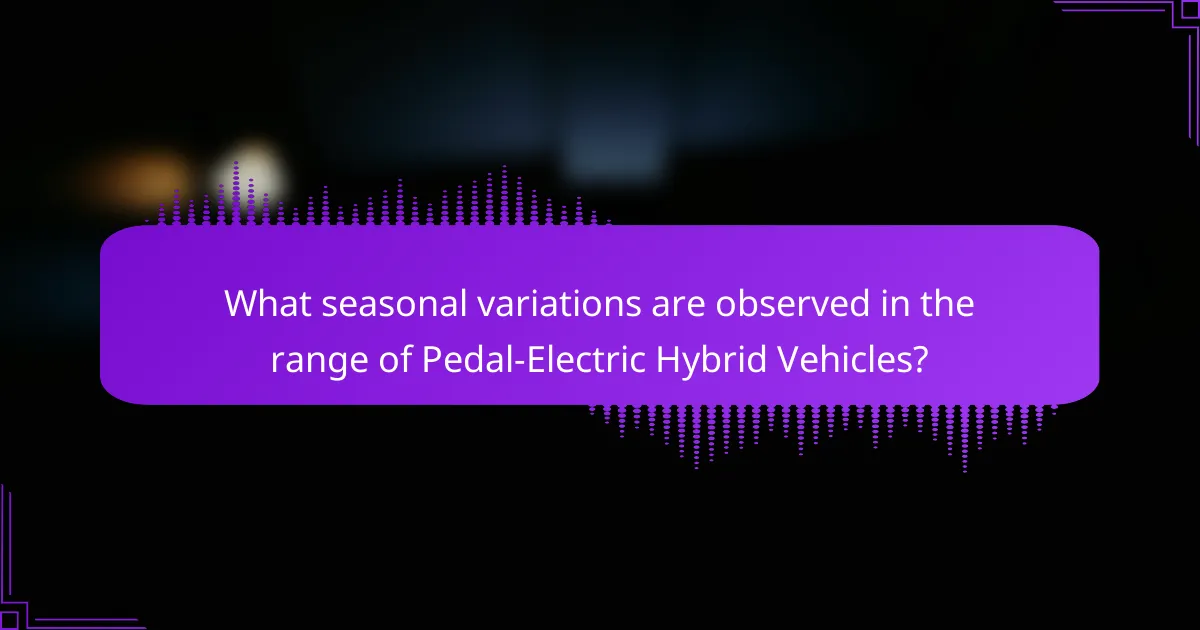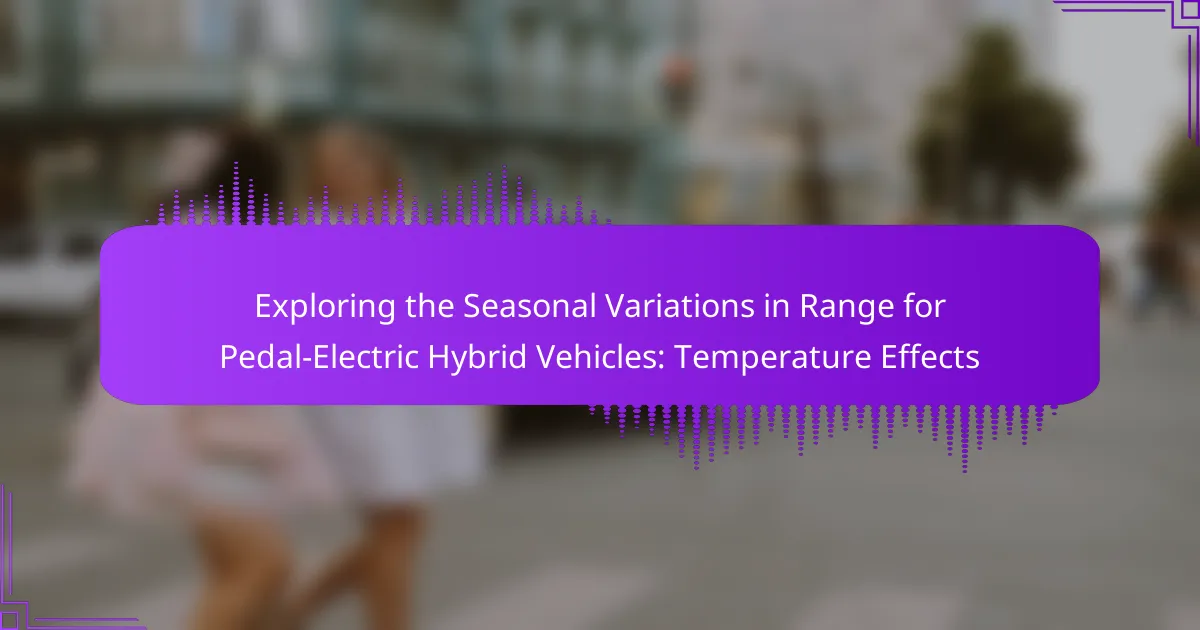
What are Pedal-Electric Hybrid Vehicles?
Pedal-electric hybrid vehicles are a type of transportation that combines human pedaling with electric assistance. These vehicles typically feature a battery-powered electric motor that engages when the rider pedals. This system enhances efficiency and extends range compared to traditional bicycles. The electric motor can provide varying levels of assistance based on rider input. Pedal-electric hybrids often include features like regenerative braking, which recharges the battery during use. They are designed for both urban commuting and recreational cycling. Studies indicate that temperature can significantly impact the performance and range of these vehicles. For example, colder temperatures may reduce battery efficiency, affecting overall range.
How do Pedal-Electric Hybrid Vehicles operate?
Pedal-electric hybrid vehicles operate by combining human pedaling with electric propulsion. The rider pedals to generate power, which is supplemented by an electric motor. This motor draws energy from a rechargeable battery. The system intelligently manages the balance between pedaling and electric assistance. When the rider pedals, the vehicle uses both sources to enhance efficiency. The electric motor assists when more power is needed, such as during acceleration. Regenerative braking captures energy during deceleration to recharge the battery. This dual system allows for extended range and improved energy efficiency.
What are the key components of Pedal-Electric Hybrid Vehicles?
The key components of Pedal-Electric Hybrid Vehicles include the electric motor, battery pack, pedal-assist system, and control unit. The electric motor provides propulsion alongside human pedaling. The battery pack stores energy for the electric motor, typically ranging from 300 Wh to 1000 Wh. The pedal-assist system detects pedaling effort and adjusts motor output accordingly. The control unit manages the interaction between the motor, battery, and pedal-assist system. These components work together to enhance efficiency and performance.
How do these components interact to influence vehicle performance?
The components of pedal-electric hybrid vehicles interact through the synergy of their electric motor, battery, and mechanical system. The electric motor provides propulsion, while the battery supplies energy. Temperature affects battery efficiency and energy output. In colder temperatures, battery capacity decreases, leading to reduced range. Conversely, warmer temperatures can enhance battery performance but may also increase energy consumption due to air conditioning use. The mechanical system, including the drivetrain, optimizes power distribution between electric and pedal inputs. This interaction ultimately determines overall vehicle performance, including acceleration, handling, and energy efficiency. Therefore, seasonal temperature variations critically influence these components’ effectiveness, impacting the hybrid vehicle’s operational range and performance metrics.
What advantages do Pedal-Electric Hybrid Vehicles provide?
Pedal-electric hybrid vehicles offer several advantages. They combine human pedaling with electric motor assistance. This dual power source enhances energy efficiency. Riders can travel longer distances with less effort. The vehicles also reduce reliance on fossil fuels. This leads to lower emissions compared to traditional vehicles. Additionally, they promote physical activity, benefiting user health. Studies show that pedal-electric hybrids can improve overall transportation sustainability.
How do these vehicles contribute to sustainability?
Pedal-electric hybrid vehicles contribute to sustainability by reducing carbon emissions and promoting energy efficiency. These vehicles combine human power and electric propulsion, which lowers reliance on fossil fuels. Studies show that they can achieve up to 60% lower emissions compared to traditional vehicles. Additionally, pedal-electric hybrids encourage active transportation, improving public health. Their design often includes regenerative braking, which recovers energy during deceleration. This feature enhances overall energy efficiency, making them a sustainable choice. Furthermore, they can operate in various climates, adapting to seasonal temperature variations while maintaining performance.
What economic benefits do users experience?
Users of pedal-electric hybrid vehicles experience significant economic benefits, primarily through reduced fuel costs. These vehicles combine human power with electric assistance, leading to lower reliance on traditional fuels. Users can save an average of 50% on fuel expenses compared to conventional vehicles. Additionally, maintenance costs are often lower due to fewer moving parts in hybrid systems. Studies show that users can save approximately $500 annually on maintenance. Furthermore, many regions offer tax incentives or rebates for electric vehicle purchases, enhancing the economic advantage. Overall, the combination of fuel savings, reduced maintenance, and potential incentives contributes to substantial economic benefits for users.

How does temperature affect the range of Pedal-Electric Hybrid Vehicles?
Temperature significantly affects the range of Pedal-Electric Hybrid Vehicles. Higher temperatures can enhance battery efficiency and improve the overall range. Conversely, lower temperatures can reduce battery performance and decrease range. Studies indicate that battery capacity diminishes in cold weather. For instance, a drop in temperature to around 0°C can lead to a range reduction of up to 20%. Additionally, the energy required for heating the cabin in colder weather further impacts range. On the other hand, moderate temperatures optimize performance and maximize efficiency.
What is the impact of cold temperatures on battery performance?
Cold temperatures negatively impact battery performance. Specifically, they reduce the chemical reactions within the battery. This leads to decreased capacity and efficiency. For lithium-ion batteries, performance can drop by approximately 20% at 0°C. At -20°C, the reduction can exceed 50%. Cold weather also increases internal resistance. This results in slower charging times and reduced power output. Studies show that battery life can be shortened in extreme cold. Overall, cold temperatures significantly hinder battery performance in electric vehicles.
How does cold weather influence charging efficiency?
Cold weather reduces charging efficiency. Low temperatures can slow down the chemical reactions in batteries. This leads to longer charging times and less effective energy transfer. Studies show that charging rates can drop by 20% to 30% in temperatures below freezing. Additionally, battery management systems may limit charging power to protect the battery. This further compounds the issue of slow charging. Overall, cold weather significantly impacts the overall performance of charging systems in pedal-electric hybrid vehicles.
What range reductions can be expected in cold conditions?
Range reductions in cold conditions can be significant for pedal-electric hybrid vehicles. Typically, drivers can expect a decrease of 20% to 40% in overall range. Cold temperatures affect battery performance and efficiency. Lithium-ion batteries, commonly used in these vehicles, experience reduced capacity in low temperatures. Studies show that battery efficiency drops by about 10% for every 10°C decrease in temperature. Additionally, increased use of heating systems further drains battery power. This results in a compounded effect on range during colder months. Overall, cold conditions pose a substantial challenge to maintaining optimal vehicle range.
How do warm temperatures affect vehicle range?
Warm temperatures generally increase vehicle range for electric and hybrid vehicles. Higher temperatures improve battery efficiency and reduce energy consumption. Batteries operate more effectively in warm conditions, allowing for greater energy output. Additionally, warm weather reduces the need for heating systems, which consume power. Studies show that electric vehicles can gain up to 20% more range in warm conditions compared to cold. This is significant, especially in regions with fluctuating seasonal temperatures. Overall, warm temperatures positively influence vehicle performance and extend driving distance.
What are the implications of heat on battery life?
Heat negatively impacts battery life by accelerating chemical reactions within the battery. Elevated temperatures can lead to increased self-discharge rates. This results in a faster depletion of the battery’s energy. Additionally, heat can cause physical damage to battery components. Lithium-ion batteries, commonly used in electric vehicles, degrade more rapidly in high temperatures. Research indicates that operating temperatures above 30°C can reduce battery lifespan by 20% or more. Maintaining optimal temperature ranges is crucial for preserving battery health and performance.
How does warm weather influence energy consumption?
Warm weather typically increases energy consumption due to higher demand for cooling systems. Air conditioning units and fans are used more frequently during hot temperatures. This leads to a rise in electricity usage, especially during peak hours. In regions with extreme heat, energy consumption can spike significantly. For example, a study by the U.S. Energy Information Administration reported that electricity demand can increase by up to 30% during summer months. Additionally, warm weather can influence the efficiency of electric vehicles. Higher temperatures can affect battery performance and range in pedal-electric hybrid vehicles. Overall, warm weather has a direct impact on energy consumption patterns.

What seasonal variations are observed in the range of Pedal-Electric Hybrid Vehicles?
Seasonal variations in the range of Pedal-Electric Hybrid Vehicles are influenced primarily by temperature changes. In colder months, battery efficiency decreases, reducing overall range. Studies show that lithium-ion batteries can lose up to 20% of their capacity in low temperatures. Conversely, warmer temperatures can enhance battery performance, increasing range. However, excessive heat may also lead to battery degradation over time. Additionally, factors like tire pressure and aerodynamics can vary with seasons, further impacting range. For example, winter tires may increase rolling resistance, reducing efficiency. Understanding these variations helps users optimize performance throughout the year.
How do different seasons impact overall vehicle performance?
Different seasons significantly impact overall vehicle performance. In winter, cold temperatures can reduce battery efficiency and increase energy consumption. For example, electric vehicle range can drop by 20-40% in sub-zero conditions. In contrast, summer heat can lead to overheating, affecting engine performance and battery life. High temperatures can also increase tire wear and decrease air density, impacting fuel efficiency. Spring and fall generally offer moderate conditions, promoting optimal performance. During these seasons, vehicles often operate closer to their designed efficiency levels. Seasonal changes in weather conditions, such as rain or snow, can also affect traction and handling, influencing overall safety and performance.
What specific challenges arise during winter months?
Winter months present specific challenges for pedal-electric hybrid vehicles. Reduced temperatures can significantly impact battery performance and efficiency. Cold weather decreases the chemical reaction rates in batteries, leading to diminished range. Additionally, increased use of heating systems can further drain battery power. Snow and ice create hazardous driving conditions, affecting traction and safety. Road salt can lead to corrosion of vehicle components, impacting longevity. Shorter daylight hours limit visibility, increasing the risk of accidents. These factors collectively reduce the overall performance and safety of pedal-electric hybrid vehicles during winter.
How do summer conditions alter driving range?
Summer conditions typically decrease the driving range of pedal-electric hybrid vehicles. Higher temperatures can lead to increased battery temperature, which affects performance. When batteries operate in heat, their efficiency can drop. This reduced efficiency results in less energy available for propulsion. Additionally, air conditioning use rises in summer, further draining battery power. Studies indicate that driving range can diminish by 10-20% in high temperatures. Furthermore, tire pressure may decrease in heat, causing increased rolling resistance. All these factors combined contribute to a noticeable reduction in driving range during summer conditions.
What strategies can be employed to optimize range throughout the seasons?
To optimize range throughout the seasons for pedal-electric hybrid vehicles, several strategies can be employed. First, maintaining optimal tire pressure is crucial. Properly inflated tires enhance efficiency and reduce energy consumption. Second, utilizing regenerative braking can extend range by converting kinetic energy back into stored energy. Third, minimizing the use of heating and air conditioning can conserve battery power. Instead, drivers should rely on seat heaters or ventilated seats when necessary. Fourth, planning routes that avoid steep inclines can reduce energy expenditure. Additionally, keeping the vehicle well-maintained ensures all systems operate efficiently. Lastly, charging during off-peak hours can help maximize battery performance. These strategies can significantly improve the range of pedal-electric hybrid vehicles across varying seasonal conditions.
How can drivers adjust their driving habits for seasonal changes?
Drivers can adjust their driving habits for seasonal changes by adapting their speed and acceleration. In colder temperatures, it is advisable to drive more slowly to maintain traction on slippery roads. Drivers should also increase following distances to allow for longer stopping times on icy surfaces.
During winter, using engine pre-heating can enhance performance and efficiency. In warmer months, drivers should use air conditioning judiciously to avoid draining battery power.
Maintaining proper tire pressure is essential, as temperature fluctuations can affect it. Regularly checking fluid levels, including coolant and windshield washer fluid, is important for optimal vehicle performance.
Adjusting driving habits according to seasonal conditions can improve safety and vehicle efficiency.
What maintenance practices can enhance performance year-round?
Regular maintenance practices can significantly enhance the performance of pedal-electric hybrid vehicles year-round. These practices include checking and maintaining tire pressure, as under-inflated tires can reduce efficiency. Regularly inspecting and replacing worn brake pads ensures optimal stopping power and safety. Maintaining the battery system is crucial; keeping terminals clean and ensuring proper charging cycles can extend battery life. Additionally, routine software updates can optimize vehicle performance and efficiency. Regular cleaning of the vehicle, especially the electrical components, prevents corrosion and maintains functionality. Following manufacturer-recommended service intervals helps identify potential issues early, ensuring the vehicle operates at peak performance.
What are the best practices for maximizing range in varying temperatures?
To maximize range in varying temperatures, maintain optimal battery temperature. Battery performance declines in extreme heat and cold. For cold conditions, precondition the battery before use. This can enhance efficiency and range. In hot weather, avoid exposing the vehicle to direct sunlight. Parking in shaded areas helps maintain battery temperature.
Regularly check tire pressure, as it can drop in colder temperatures. Properly inflated tires improve efficiency. Use energy-saving driving modes when available. These modes optimize power consumption. Lastly, limit the use of climate control systems. This reduces energy draw and extends range.
Pedal-electric hybrid vehicles are a unique mode of transportation that integrates human pedaling with electric motor assistance, enhancing efficiency and range. This article explores how seasonal temperature variations impact the performance and range of these vehicles, detailing the influence of both cold and warm conditions on battery efficiency and overall vehicle operation. Key components such as the electric motor, battery pack, and control unit are examined, alongside strategies for optimizing performance throughout the year. Additionally, the article discusses the economic and environmental benefits of pedal-electric hybrids, emphasizing their role in promoting sustainability and reducing emissions.
